9.22: Vascular Plants
- Page ID
- 12222
\( \newcommand{\vecs}[1]{\overset { \scriptstyle \rightharpoonup} {\mathbf{#1}} } \)
\( \newcommand{\vecd}[1]{\overset{-\!-\!\rightharpoonup}{\vphantom{a}\smash {#1}}} \)
\( \newcommand{\dsum}{\displaystyle\sum\limits} \)
\( \newcommand{\dint}{\displaystyle\int\limits} \)
\( \newcommand{\dlim}{\displaystyle\lim\limits} \)
\( \newcommand{\id}{\mathrm{id}}\) \( \newcommand{\Span}{\mathrm{span}}\)
( \newcommand{\kernel}{\mathrm{null}\,}\) \( \newcommand{\range}{\mathrm{range}\,}\)
\( \newcommand{\RealPart}{\mathrm{Re}}\) \( \newcommand{\ImaginaryPart}{\mathrm{Im}}\)
\( \newcommand{\Argument}{\mathrm{Arg}}\) \( \newcommand{\norm}[1]{\| #1 \|}\)
\( \newcommand{\inner}[2]{\langle #1, #2 \rangle}\)
\( \newcommand{\Span}{\mathrm{span}}\)
\( \newcommand{\id}{\mathrm{id}}\)
\( \newcommand{\Span}{\mathrm{span}}\)
\( \newcommand{\kernel}{\mathrm{null}\,}\)
\( \newcommand{\range}{\mathrm{range}\,}\)
\( \newcommand{\RealPart}{\mathrm{Re}}\)
\( \newcommand{\ImaginaryPart}{\mathrm{Im}}\)
\( \newcommand{\Argument}{\mathrm{Arg}}\)
\( \newcommand{\norm}[1]{\| #1 \|}\)
\( \newcommand{\inner}[2]{\langle #1, #2 \rangle}\)
\( \newcommand{\Span}{\mathrm{span}}\) \( \newcommand{\AA}{\unicode[.8,0]{x212B}}\)
\( \newcommand{\vectorA}[1]{\vec{#1}} % arrow\)
\( \newcommand{\vectorAt}[1]{\vec{\text{#1}}} % arrow\)
\( \newcommand{\vectorB}[1]{\overset { \scriptstyle \rightharpoonup} {\mathbf{#1}} } \)
\( \newcommand{\vectorC}[1]{\textbf{#1}} \)
\( \newcommand{\vectorD}[1]{\overrightarrow{#1}} \)
\( \newcommand{\vectorDt}[1]{\overrightarrow{\text{#1}}} \)
\( \newcommand{\vectE}[1]{\overset{-\!-\!\rightharpoonup}{\vphantom{a}\smash{\mathbf {#1}}}} \)
\( \newcommand{\vecs}[1]{\overset { \scriptstyle \rightharpoonup} {\mathbf{#1}} } \)
\( \newcommand{\vecd}[1]{\overset{-\!-\!\rightharpoonup}{\vphantom{a}\smash {#1}}} \)
\(\newcommand{\avec}{\mathbf a}\) \(\newcommand{\bvec}{\mathbf b}\) \(\newcommand{\cvec}{\mathbf c}\) \(\newcommand{\dvec}{\mathbf d}\) \(\newcommand{\dtil}{\widetilde{\mathbf d}}\) \(\newcommand{\evec}{\mathbf e}\) \(\newcommand{\fvec}{\mathbf f}\) \(\newcommand{\nvec}{\mathbf n}\) \(\newcommand{\pvec}{\mathbf p}\) \(\newcommand{\qvec}{\mathbf q}\) \(\newcommand{\svec}{\mathbf s}\) \(\newcommand{\tvec}{\mathbf t}\) \(\newcommand{\uvec}{\mathbf u}\) \(\newcommand{\vvec}{\mathbf v}\) \(\newcommand{\wvec}{\mathbf w}\) \(\newcommand{\xvec}{\mathbf x}\) \(\newcommand{\yvec}{\mathbf y}\) \(\newcommand{\zvec}{\mathbf z}\) \(\newcommand{\rvec}{\mathbf r}\) \(\newcommand{\mvec}{\mathbf m}\) \(\newcommand{\zerovec}{\mathbf 0}\) \(\newcommand{\onevec}{\mathbf 1}\) \(\newcommand{\real}{\mathbb R}\) \(\newcommand{\twovec}[2]{\left[\begin{array}{r}#1 \\ #2 \end{array}\right]}\) \(\newcommand{\ctwovec}[2]{\left[\begin{array}{c}#1 \\ #2 \end{array}\right]}\) \(\newcommand{\threevec}[3]{\left[\begin{array}{r}#1 \\ #2 \\ #3 \end{array}\right]}\) \(\newcommand{\cthreevec}[3]{\left[\begin{array}{c}#1 \\ #2 \\ #3 \end{array}\right]}\) \(\newcommand{\fourvec}[4]{\left[\begin{array}{r}#1 \\ #2 \\ #3 \\ #4 \end{array}\right]}\) \(\newcommand{\cfourvec}[4]{\left[\begin{array}{c}#1 \\ #2 \\ #3 \\ #4 \end{array}\right]}\) \(\newcommand{\fivevec}[5]{\left[\begin{array}{r}#1 \\ #2 \\ #3 \\ #4 \\ #5 \\ \end{array}\right]}\) \(\newcommand{\cfivevec}[5]{\left[\begin{array}{c}#1 \\ #2 \\ #3 \\ #4 \\ #5 \\ \end{array}\right]}\) \(\newcommand{\mattwo}[4]{\left[\begin{array}{rr}#1 \amp #2 \\ #3 \amp #4 \\ \end{array}\right]}\) \(\newcommand{\laspan}[1]{\text{Span}\{#1\}}\) \(\newcommand{\bcal}{\cal B}\) \(\newcommand{\ccal}{\cal C}\) \(\newcommand{\scal}{\cal S}\) \(\newcommand{\wcal}{\cal W}\) \(\newcommand{\ecal}{\cal E}\) \(\newcommand{\coords}[2]{\left\{#1\right\}_{#2}}\) \(\newcommand{\gray}[1]{\color{gray}{#1}}\) \(\newcommand{\lgray}[1]{\color{lightgray}{#1}}\) \(\newcommand{\rank}{\operatorname{rank}}\) \(\newcommand{\row}{\text{Row}}\) \(\newcommand{\col}{\text{Col}}\) \(\renewcommand{\row}{\text{Row}}\) \(\newcommand{\nul}{\text{Nul}}\) \(\newcommand{\var}{\text{Var}}\) \(\newcommand{\corr}{\text{corr}}\) \(\newcommand{\len}[1]{\left|#1\right|}\) \(\newcommand{\bbar}{\overline{\bvec}}\) \(\newcommand{\bhat}{\widehat{\bvec}}\) \(\newcommand{\bperp}{\bvec^\perp}\) \(\newcommand{\xhat}{\widehat{\xvec}}\) \(\newcommand{\vhat}{\widehat{\vvec}}\) \(\newcommand{\uhat}{\widehat{\uvec}}\) \(\newcommand{\what}{\widehat{\wvec}}\) \(\newcommand{\Sighat}{\widehat{\Sigma}}\) \(\newcommand{\lt}{<}\) \(\newcommand{\gt}{>}\) \(\newcommand{\amp}{&}\) \(\definecolor{fillinmathshade}{gray}{0.9}\)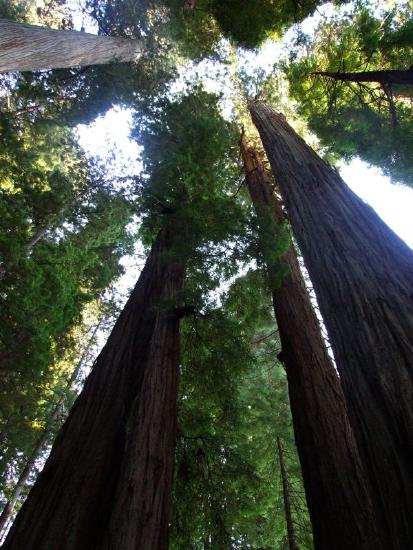
How does water move from the roots to the top of these trees?
Redwood trees found in Yosemite National Park in California. Big? Of course. How do these trees grow so tall? It has a lot to do with a very efficient system to move water, sugars and other nutrients. But the first plants to have such a "vascular system" were not tall trees, but much smaller plants.
Vascular Plants
Vascular plants are known as tracheophytes, which literally means “tube plants.” The earliest vascular plants quickly came to dominate terrestrial ecosystems. Why were they so successful? It was mainly because of their tube-like vascular tissues.
Vascular Tissues
The vascular tissues for which these plants are named are specialized to transport fluid. They consist of long, narrow cells arranged end-to-end, forming tubes. There are two different types of vascular tissues, called xylem and phloem. Both are shown in Figure below.
- Xylem is vascular tissue that transports water and dissolved minerals from roots to stems and leaves. This type of tissue consists of dead cells that lack end walls between adjacent cells. The side walls are thick and reinforced with lignin, which makes them stiff and water proof.
- Phloem is vascular tissue that transports food (sugar dissolved in water) from photosynthetic cells to other parts of the plant for growth or storage. This type of tissue consists of living cells that are separated by end walls with tiny perforations, or holes.
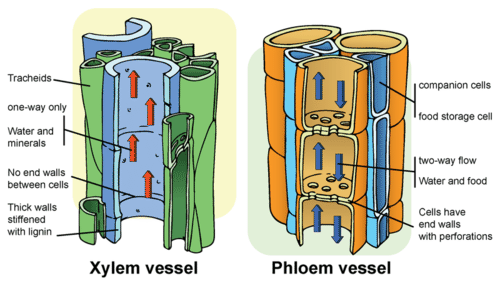 Xylem and phloem are the two types of vascular tissues in vascular plants.
Xylem and phloem are the two types of vascular tissues in vascular plants.Evolution of Vascular Plants
The first vascular plants evolved about 420 million years ago. They probably evolved from moss-like bryophyte ancestors, but they had a life cycle dominated by the diploid sporophyte generation. As they continued to evolve, early vascular plants became more plant-like in other ways as well.
- Vascular plants evolved true roots made of vascular tissues. Compared with rhizoids, roots can absorb more water and minerals from the soil. They also anchor plants securely in the ground, so plants can grow larger without toppling over.
- Vascular plants evolved stems made of vascular tissues and lignin. Because of lignin, stems are stiff, so plants can grow high above the ground where they can get more light and air. Because of their vascular tissues, stems keep even tall plants supplied with water so they don’t dry out in the air.
- Vascular plants evolved leaves to collect sunlight. At first, leaves were tiny and needle-like, which helped reduce water loss. Later, leaves were much larger and broader, so plants could collect more light.
With their vascular tissues and other adaptations, early vascular plants had the edge over nonvascular plants. The could grow tall and take advantage of sunlight high up in the air. Bryophytes were the photosynthetic pioneers onto land, but early vascular plants were the photosynthetic pioneers into air.
Diversity of Seedless Vascular Plants
Surviving descendants of early vascular plants include clubmosses and ferns. There are 1,200 species of clubmoss and more than 20,000 species of fern. Both types of vascular plants are seedless and reproduce with spores. Two examples are pictured in Figures below and below.
- Clubmosses look like mosses and grow low to the ground. Unlike mosses, they have roots, stems, and leaves, although the leaves are very small.
- Ferns look more like “typical” plants. They have large leaves and may grow very tall. Some even develop into trees.
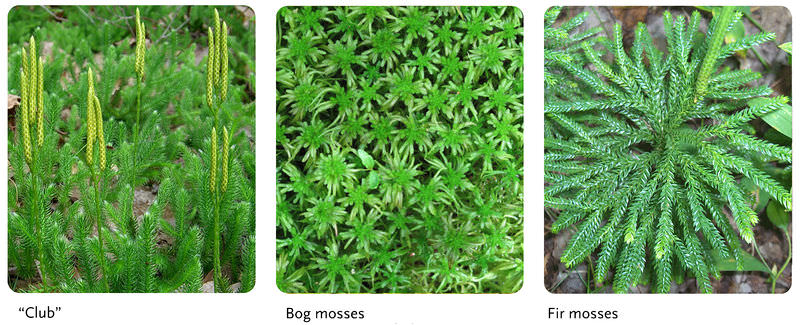 Clubmosses like these are often confused with mosses.
Clubmosses like these are often confused with mosses.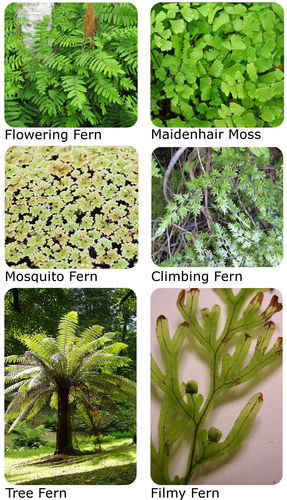 There’s no confusing ferns with mosses. Why do these ferns look more plant-like?
There’s no confusing ferns with mosses. Why do these ferns look more plant-like?Summary
- Vascular plants are known as tracheophytes.
- Vascular tissues include xylem and phloem. They allow plants to grow tall in the air without drying out.
- Vascular plants also have roots, stems, and leaves.
Review
- Compare xylem to phloem.
- How did vascular tissues and lignin allow vascular plants to be “photosynthetic pioneers into air”?
- Why are roots more advantageous to a plant than rhizoids?
- What benefits do stems provide to a plant?
| Image | Reference | Attributions |
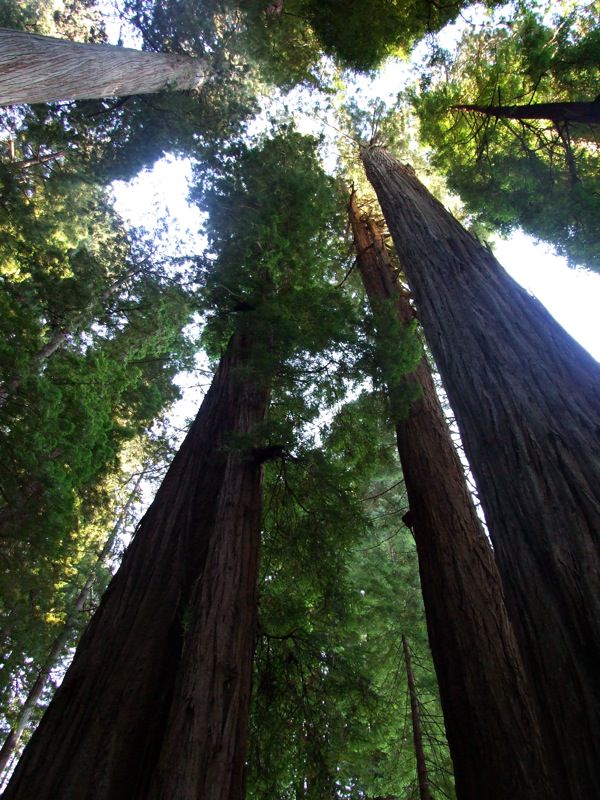 |
[Figure 1] | Credit: Mariana Ruiz Villarreal (LadyofHats) for CK-12 Foundation Source: CK-12 Foundation License: CC BY-NC |
 |
[Figure 2] | Credit: Mariana Ruiz Villarreal (LadyofHats) for CK-12 Foundation;Flickr:j bizzie Source: CK-12 Foundation ; http://www.flickr.com/photos/k9d/8237716406/ License: CC BY-NC 3.0; CC BY 2.0 |
 |
[Figure 3] | Credit: Club: Jason Hollinger; Bog: Gary Peeples/USFWS; Fir: Homer Edward Price Source: Club: http://www.flickr.com/photos/7147684@N03/1289194411/ ; Bog: http://www.flickr.com/photos/usfwssoutheast/4660978704/ ; Fir: http://www.flickr.com/photos/28340342@N08/2979277365/ License: CC BY 2.0 |
 |
[Figure 4] | Credit: Flowering: Rhian; Maidenhair: Anika Malone; Mosquito: Samantha; Climbing: Forest & Kim Starr; Tree: Tim Green; Filmy: Forest & Kim Starr Source: Flowering: http://www.flickr.com/photos/rhian/2580492884/ ; Maidenhair: http://www.flickr.com/photos/anikascreations/531598552/ ; Mosquito: http://www.flickr.com/photos/s-a-m/7169501757/ ; Climbing: www.biolib.cz/en/image/id51473/ ; Tree: http://www.flickr.com/photos/atoach/2800026937/ ; Climbing: www.biolib.cz/en/image/id51473/ ; Filmy: www.flickr.com/photos/starr-environmental/9063214435/ License: Flowering: CC BY; Maidenhair: CC BY 2.0; Mosquito: CC BY 2.0; Climbing CC BY 3.0; Tree CC BY 2.0; Filmy CC BY 2.0 |

